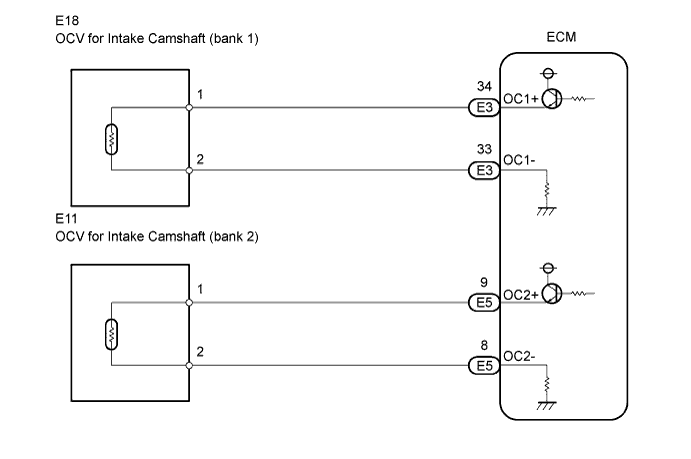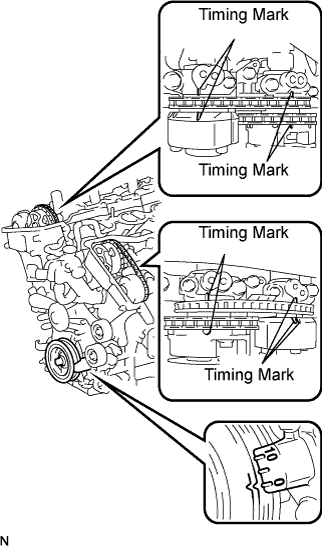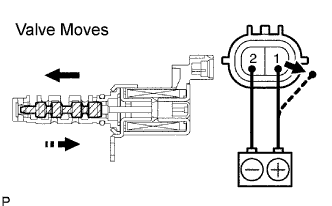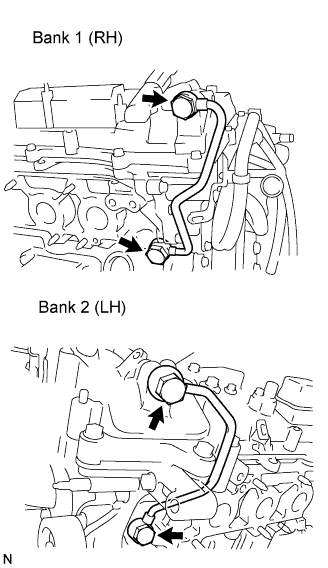Lexus IS250 IS220d GSE20 ALE20 4GR-FSE ENGINE CONTROL SYSTEM
CHECK ANY OTHER DTCS OUTPUT (IN ADDITION TO DTC P0011, P0012, P0021 OR P0022)
PERFORM ACTIVE TEST BY INTELLIGENT TESTER (OPERATE OCV)
CHECK WHETHER DTC OUTPUT RECURS (DTC P0011, P0012, P0021 OR P0022)
CHECK VALVE TIMING (CHECK FOR LOOSE AND JUMPED TEETH ON TIMING CHAIN)
INSPECT CAMSHAFT TIMING OIL CONTROL VALVE ASSEMBLY (OCV)
INSPECT OIL CONTROL VALVE FILTER AND PIPE
REPLACE CAMSHAFT TIMING GEAR ASSEMBLY
CHECK WHETHER DTC OUTPUT RECURS
DTC P0011 Camshaft Position "A" - Timing Over-Advanced or System Performance (Bank 1)
DTC P0012 Camshaft Position "A" - Timing Over-Retarded (Bank 1)
DTC P0021 Camshaft Position "A" - Timing Over-Advanced or System Performance (Bank 2)
DTC P0022 Camshaft Position "A" - Timing Over-Retarded (Bank 2)
DESCRIPTION
The Variable Valve Timing (VVT) system includes the ECM, Oil Control Valve (OCV) and VVT controller. The ECM sends a target duty-cycle control signal to the OCV. This control signal regulates the oil pressure supplied to the VVT controller. Camshaft timing control is performed according to engine operating conditions such as intake air volume, throttle valve position and engine coolant temperature. The ECM controls the OCV, based on the signals transmitted by several sensors. The VVT controller regulates the intake camshaft angle using oil pressure through the OCV. As a result, the relative positions of the camshaft and crankshaft are optimized, the engine torque and fuel economy improves, and the exhaust emissions decrease under overall driving conditions. The ECM detects the actual intake valve timing using signals from the camshaft and crankshaft position sensors, and performs feedback control. This is how the target intake valve timing is verified by the ECM.
| DTC No. | DTC Detection Condition | Trouble Area |
| P0011 P0021 | Advanced cam timing: With warm engine and engine speed of between 500 rpm and 4,000 rpm, all conditions (1), (2) and (3) met (1 trip detection logic): 1. Difference between target and actual intake valve timing more than 5°CA (Crankshaft Angle) for 4.5 seconds 2. Current intake valve timing fixed (timing changes less than 5°CA in 5 seconds) 3. Variations in VVT controller timing more than 19°CA of maximum delayed timing (advance) | Valve timing Oil Control valve (OCV) for intake camshaft (bank 1) OCV filter (bank 1) Intake camshaft (bank 1) timing gear assembly ECM |
| P0012 P0022 | Retarded cam timing: With warm engine and engine speed of between 500 rpm and 4,000 rpm, all conditions (1), (2) and (3) met (2 trip detection logic): 1. Difference between target and actual intake valve timing more than 5°CA (Crankshaft Angle) for 4.5 seconds 2. Current intake valve timing fixed (timing changes less than 5°CA in 5 seconds) 3. Variations in VVT controller timing 19°CA or less of maximum delayed timing (retarded) | Valve timing OCV for intake camshaft (bank 2) OCV filter (bank 2) Intake camshaft (bank 2) timing gear assembly ECM |
WIRING DIAGRAM

INSPECTION PROCEDURE
- HINT:
| Abnormal bank | Advanced timing over (Valve timing is out of specified range) | Retarded timing over (Valve timing is out of specified range) |
| Bank 1 | P0011 | P0012 |
| Bank 2 | P0021 | P0022 |
| 1.CHECK ANY OTHER DTCS OUTPUT (IN ADDITION TO DTC P0011, P0012, P0021 OR P0022) |
Connect the intelligent tester to the DLC3.
Turn the engine switch on (IG) and turn the tester ON.
Enter the following menus: Power train / Engine / DTC.
Read DTCs.
- Result:
Display (DTC Output) Proceed to P0011, P0012, P0021 or P0022 A P0011, P0012, P0021 or P0022 and other DTCs B
- HINT:
- If any DTCs other than P0011, P0012, P0021 or P0022 are output, troubleshoot those DTCs first.
|
| ||||
| OK | |
| 3.CHECK WHETHER DTC OUTPUT RECURS (DTC P0011, P0012, P0021 OR P0022) |
Connect the intelligent tester to the DLC3.
Turn the engine switch on (IG) and turn the tester ON.
Clear DTCs.
Start the engine and warm it up.
Switch the ECM from normal mode to check mode using the tester.
Drive the vehicle for more than 10 minutes.
Read DTCs using the tester.
- OK:
- No DTC output.
|
| ||||
| OK | ||
| ||
| 4.CHECK VALVE TIMING (CHECK FOR LOOSE AND JUMPED TEETH ON TIMING CHAIN) |

Remove the cylinder head covers RH and LH.
Turn the crankshaft pulley, and align its groove with the timing mark "0" of the timing chain cover.
Check that the timing marks of the camshaft timing gears are aligned with the timing marks of the bearing cap as shown in the illustration.
If not, turn the crankshaft 1 revolution (360°), then align the marks as above.
- OK:
- Timing marks on camshaft timing gears are aligned as shown in the illustration.
Reinstall the cylinder head covers.
|
| ||||
| OK | |
| 5.INSPECT CAMSHAFT TIMING OIL CONTROL VALVE ASSEMBLY (OCV) |

Remove the OCV.
Measure the resistance between the terminals of the OCV.
- Standard resistance:
- 6.9 to 7.9 Ω at 20°C (68°F)
Apply positive battery voltage to terminal 1 and negative battery voltage to terminal 2. Check the valve operation.
- OK:
- Valve moves quickly.
Reinstall the OCV.
|
| ||||
| OK | |
| 6.INSPECT OIL CONTROL VALVE FILTER AND PIPE |

Remove the oil pipe No. 1 or No. 2.
Remove the oil control valve filter.
Check that the filter and pipe are not clogged.
- OK:
- The filter and pipe are not clogged.
|
| ||||
| OK | |
| 7.REPLACE CAMSHAFT TIMING GEAR ASSEMBLY |
| NEXT | |
| 8.CHECK WHETHER DTC OUTPUT RECURS |
Connect the intelligent tester to the DLC3.
Turn the engine switch on (IG) and turn the tester ON.
Clear DTCs.
Start the engine and warm up.
Switch the ECM from normal mode to the check mode using the tester.
Driver the vehicle for more than 10 minutes.
Read output DTCs using the intelligent tester.
- OK:
- No DTC output.
- HINT:
- DTC P0011, P0012, P0021 or P0022 is output when foreign objects in engine oil are caught in some parts of the system. These codes will stay registered even if the system returns to normal after a short time. These foreign objects are then captured by the oil filter, thus eliminating the source of the problem.
|
| ||||
| NG | ||
| ||